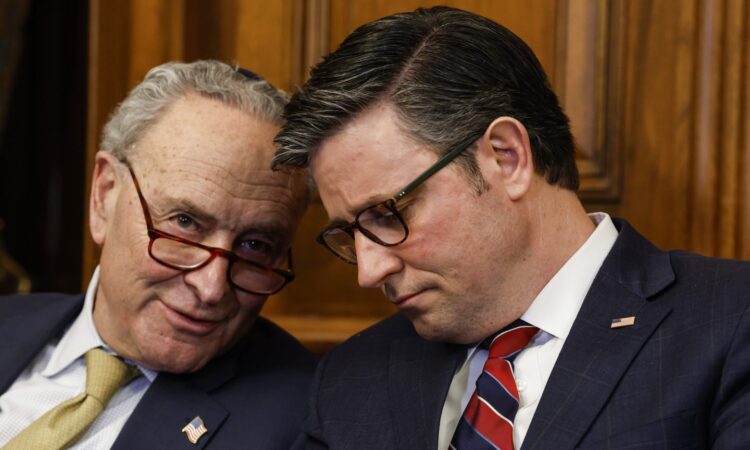
Updated on Jan. 18: With less than 36 hours until a partial shutdown of the federal government, Congress passed a stopgap that extends funding for the government into March. The continuing resolution was introduced on Sunday by Congressional leaders and approved by both houses on Thursday. Like the extension that passed in November, the stopgap is two-tiered, shifting the shutdown deadline to March 1 and March 8, depending on the department that needs funding approval.
The government is headed for a potential shutdown. Again. And that means Congress must either pass crucial budget appropriations or agree on yet another funding extension.
Shutdowns are disruptive for the federal government at large. For consumers, a government shutdown could result in various problems and inconveniences. But unless you work for the federal government, a government shutdown might not have an immediate impact on you.
Here’s what went down with the government shutdown drama of 2023 and 2024:
-
Federal agencies are legally required to have approved appropriations from Congress in order to spend money.
-
Congress must fund 12 key appropriation bills in order to fund the government for its new fiscal year, which began Oct. 1.
-
A last-minute stopgap was passed Sept. 30 and extended government funding through Nov. 17.
-
The House fell into a leadership crisis in October, which delayed any movement on preventing the shutdown. Then-House Speaker Kevin McCarthy was ousted and it took weeks to elect Mike Johnson to the post.
-
Once Johnson took the helm he led the passage of another stopgap in mid-November — with crucial help from House Democrats. The stopgap extended funding into 2024.
-
This time the continuing resolution split the extension into two dates: Jan. 19 for military and veterans programs and the departments of transportation, housing and urban development, agriculture, as well as energy and water. And Feb. 2 for multiple other departments including the state, justice, defense, commerce, labor, as well as Health and Human Services.
-
On Jan. 7, Congress reached an agreement on spending levels for the fiscal year to the tune of nearly $1.7 trillion. Senate Majority Leader Chuck Schumer and House Speaker Mike Johnson negotiated the bipartisan deal, but hardline Republicans in the House expressed vehement opposition that has made the deal unlikely to pass.
-
On Jan. 14, Schumer and Johnson unveiled a continuing resolution that extends government funding into March.
-
On Jan. 18, Congress passed the continuing resolution. Lawmakers now have six weeks to act to approve funding for the 2023-2024 fiscal year.
What is a government shutdown?
When the government shuts down, many federal agencies must suspend all non-essential services. Each federal agency must develop its own contingency plan for shutdowns, which includes employee furloughs and service reductions.
When will the government shut down?
The government is expected to partially shut down as early as Jan. 19. A second partial shutdown could happen on Feb. 2. Congress must act to prevent both shutdowns either with a spending bill or continuing resolution.
Who is affected by a government shutdown?
-
The brunt of the disruption would fall on furloughed government workers. But all federal workers go without pay during a shutdown even if they’re not furloughed. Federal workers are paid retroactively once funding is restored.
-
Non-essential services that would be suspended likely include national parks, the Internal Revenue Service’s customer service and Federal Student Aid assistance (although you can still apply for aid — and those student loan bills are still due beginning in October).
-
Any programs that receive mandatory funding will continue operations. That includes essential services, such as air traffic control, law enforcement, power grid maintenance, in-hospital medical care and border protection, according to the Center for a Responsible Federal Budget.
-
It could hamper your homebuying plans if you are trying to get a reverse mortgage or Title I loan insured by the Federal Housing Administration or a loan from the U.S. Department of Agriculture.
Some essential services will continue, but service may be reduced including:
-
Food and environmental inspections through the Food and Drug Administration and the Environmental Protection Agency would likely be halted or reduced.
-
The Centers for Disease Control and Prevention as well as the National Institutes of Health could also see reduced operations — not ideal during a covid surge.
When was the last government shutdown?
There have been 21 government shutdowns since 1976. The most recent government shutdown was also the longest yet, beginning on Dec. 22, 2018 and lasting until Jan. 25, 2019 — a total of 34 full days. However, most past shutdowns lasted less than a week.
Government shutdowns are costly in more ways than one: The 2018 to 2019 partial shutdown cost $18 billion in federal discretionary spending and reduced Gross Domestic Product (GDP) by $11 billion, according to the Congressional Budget Office.
When Congress passes some but not all of the required appropriations, the result is a partial shutdown.
(Photo by Anna Moneymaker/Getty Images News via Getty Images)






